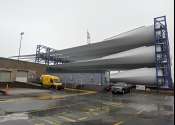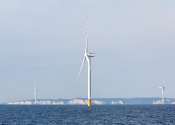Wind is the flow of air or other gases that compose an atmosphere (including that of the planet Earth). On Earth and within other planetary atmospheres, wind consists of air molecules in motion. In outer space, solar wind is the movement of gases or charged particles from the sun through space, while planetary wind is the outgassing of light chemical elements from a planet's atmosphere into space. Differences in density between two air masses lead to wind. Winds are commonly classified by their spatial scale, their speed, the types of forces that cause them, the geographic regions in which they occur, and their effect. While wind is often a standalone weather phenomenon, it can also occur as part of a storm system, most notably in a cyclone. While winds on Earth can be strong, the strongest winds within a planet in our solar system lie on Neptune and Saturn.
Winds are plotted on surface weather analyses indicating the direction the wind is blowing from as well as its strength, and over much of the globe wind speeds are measured over a ten-minute time frame, with the United States and India using different averaging intervals. Shorter duration winds, such as wind gusts, exceed the minimum value over the observed time frame and can cause substantial damage to power lines and suspension bridges. Winds with an intermediate duration, which sharply increase and last for a minute are termed squalls. Long-duration wind speeds have various names associated with their average strength, such as breeze, gale, storm, hurricane, and typhoon. Wind occurs on a range of scales, from local breezes generated by heating of land surfaces and lasting tens of minutes, to global winds resulting from the difference in absorption of solar energy between the climate zones on Earth. The two major driving factors of large scale atmospheric circulation are the differential heating between the equator and the poles, which causes the jet stream and the associated climatological mid-latitude westerlies, polar easterlies, and the trade winds, and the rotation of the planet (Coriolis effect), which causes the circular motion of air around areas of high and low pressure. Within the tropics, thermal low circulations over terrain and high plateaus can drive monsoon circulations. In areas where winds tend to be light, the sea breeze/land breeze cycle is the most important to the prevailing wind; in areas that have variable terrain, mountain and valley breezes dominate the wind pattern.
In human civilization, wind has inspired mythology, influenced the events of history, expanded the range of transport and warfare, and provided a power source for mechanical work, electricity, and recreation. Wind has been used to steer sailing ships across vast oceans. By air, hot air balloons use the wind to take short trips. Airships have historically been used for longer trips, but nowadays are used for a variety of monitoring efforts such as during public sporting events and drug trafficking efforts. Wind can be dangerous, as areas of wind shear caused by various weather phenomena can lead to dangerous situations for airplanes. When winds become strong, trees and man-made structures are damaged or destroyed.
Winds can shape landforms, via a variety of aeolian processes such as the formation of fertile soils, such as loess, and by erosion. Dust from large deserts can be moved large distances from their source region by the prevailing winds. Winds that are accelerated by rough topography and associated with dust outbreaks have been assigned regional names in various parts of the world due to their significant effects on those regions. Wind helps to spread wildfires. Nature uses wind to help disperse seeds from various plants, in order to enable the survival of those plant species, as well as flying insect populations. When combined with cold temperatures, wind has a negative impact on livestock. Wind impacts animal food stores, as well as their hunting and defensive strategies.









